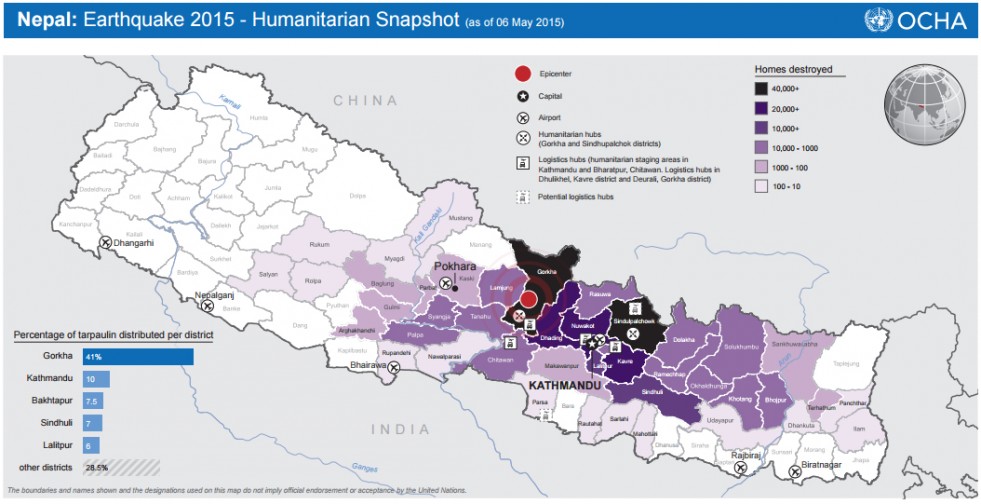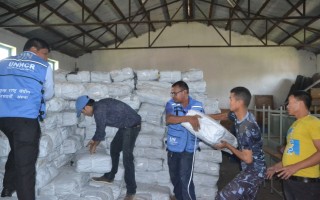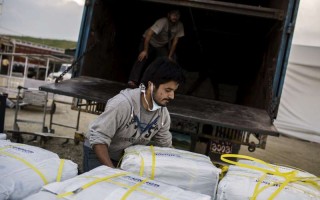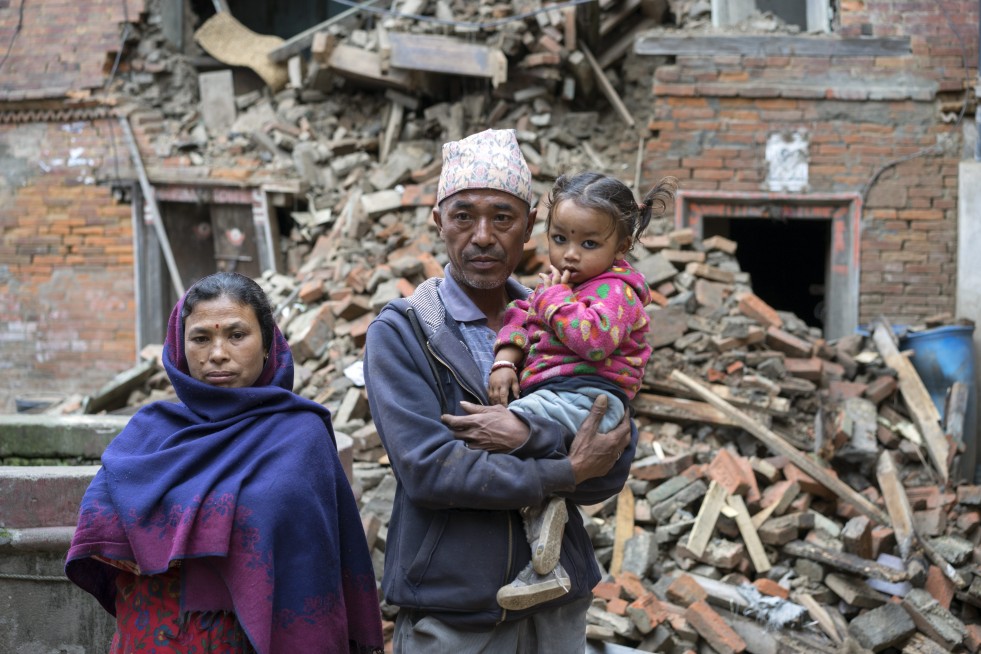
Parents – mother Mishri Tatya, 40 and father Chandra Gopal Tatya, 49 with one-and-half-year-old grandson Sudip Tatya in Bhaktapur.
© UNHCR / Brian Sokol
The strongest earthquake to hit Nepal for 80 years
On 25 April at 11:56 local time, a 7.8 magnitude earthquake struck Nepal, creating large scale damage, many deaths and many more injuries. The epicenter of the earthquake was located 81 km northwest of the Nepali capital, Kathmandu, in Lamjung District, at a depth of 15 km underground. The earthquake claimed the lives of more than 7,500 people. The earthquake also caused landslides and avalanches, including one on Mount Everest that killed at least 19 people, making it the deadliest day on the mountain in history. Strong aftershocks, like the 6.7 magnitude earthquake on 26 April, continue to threaten the lives of thousands of people and destroy buildings, many of which rank among the world’s protected heritage sites. According to initial estimations and based on the latest earthquake intensity mapping, over 8 million people are affected in more than half of Nepal’s 75 districts, and of the 11 most critically affected districts, over 2 million people have seen their lives utterly shattered. Nepal, already deeply affected by poverty and sitting 145th of 187 countries in the human development index, has now been dealt a massive blow to its infrastructure.
UNHCR stands in solidarity with Nepal, which has been a generous host to thousands of refugees over the years.”
– Daisy Dell, UNHCR Director of the Asia-Pacific bureau
Devastating impact on ordinary families
An estimated 2.8 million people are living in the open and in need of assistance and protection. The Government of Nepal estimates that almost 170,000 houses have been destroyed and another 143,000 badly damaged. Shelter is the single most important and urgent need. Sleeping outside can have the most devastating effect on health—particularly for the very young and the very old, as well as the more than 14,000 people who are injured. Most have no access to electricity or water, and with all attention on relief efforts it is unclear when infrastructure and utilities will be significantly restored.
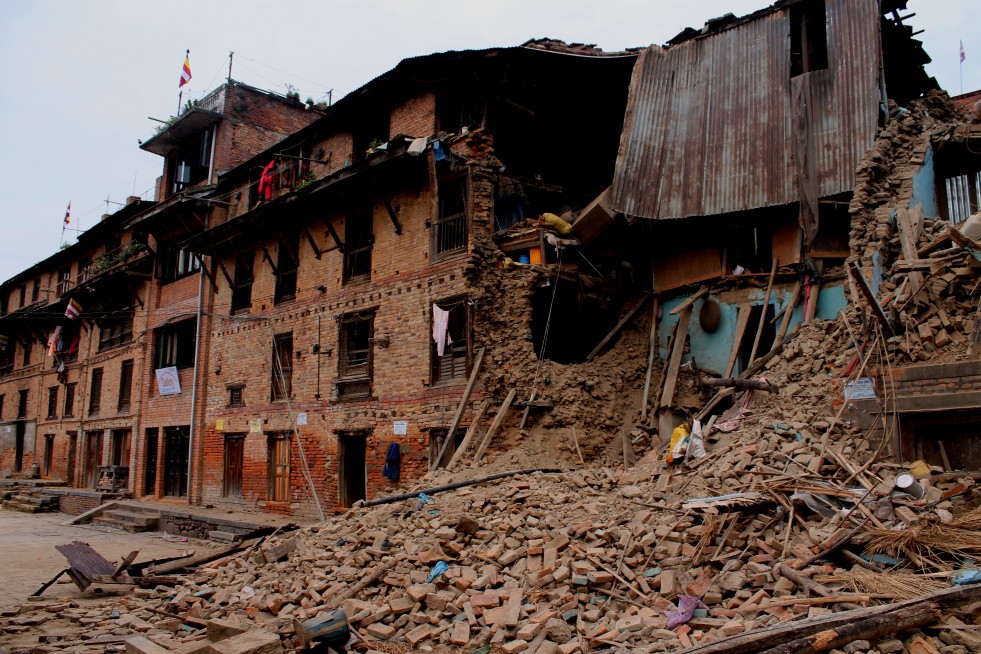
Houses destroyed by the earthquake in a small town of Bungamati in the outskirts of Kathmandu. © UNHCR / D. Shrestha
Bad weather continues to threaten lives
At the moment, Kathmandu is still experiencing heavy rainfall. The need to provide those affected by the earthquake with tents and tarps for survival is urgent. The unusual heavy rainfall was forecast to persist for the coming days by the local weather bureau, adding yet another burden on the shoulders of those who survived the earthquake. The rain is also causing landslides, which are blocking the roads and hampering aid operations. Another victim of such adverse conditions are airports, dispatching operational efforts around the clock to keep runways open and allow flights, including those from UNHCR, to land. But today’s weather is not the only threat—the clock is ticking, and there are no more than 8 weeks before Nepal’s rainy season hits. This means we have only 6 to 8 weeks to provide shelter to thousands of survivors and to prepare for the looming threat of disease and further devastation.
UNHCR first agency to respond, providing immediate emergency care & support
UNHCR and the Nepali government have been working together since the early 1960s to care for refugees and asylum-seekers, mainly from Tibet and Bhutan. Some 25,000 refugees from Bhutan now live in two UNHCR camps in the Eastern Region of Nepal.
UNHCR staff were on the ground when the earthquake hit, and were able to respond immediately by delivering life-saving assistance to people who had lost everything. Within 24 hours, UNHCR staff had organized and delivered plastic sheets, solar lamps and other basic supplies to meet the most urgent needs of survivors.
Trucks left our warehouses in Damak in the southeast of Nepal, to distribute 11,000 plastic sheets and 4,000 solar to the eastern districts of Nepal which have been gravely devastated by aftershocks and which had not received any of the aid efforts on the ground thus far. The Government requested that we distribute to these eastern provinces so we began immediate distributions along route, witnessing entire villages that have been nearly flattened along the roads.
– Joung-ah Ghedini Williams, UNHCR PSFR Emergencies Co-ordinator
All supplies in the area—including those located in other countries for the region’s refugee populations—were immediately redirected to provide support in the Eastern Region, along with supplies from the UN staff food store. UNHCR is the only agency working in the 3 eastern provinces where support is provided and also supplying vital shelter materials in Kathmandu.
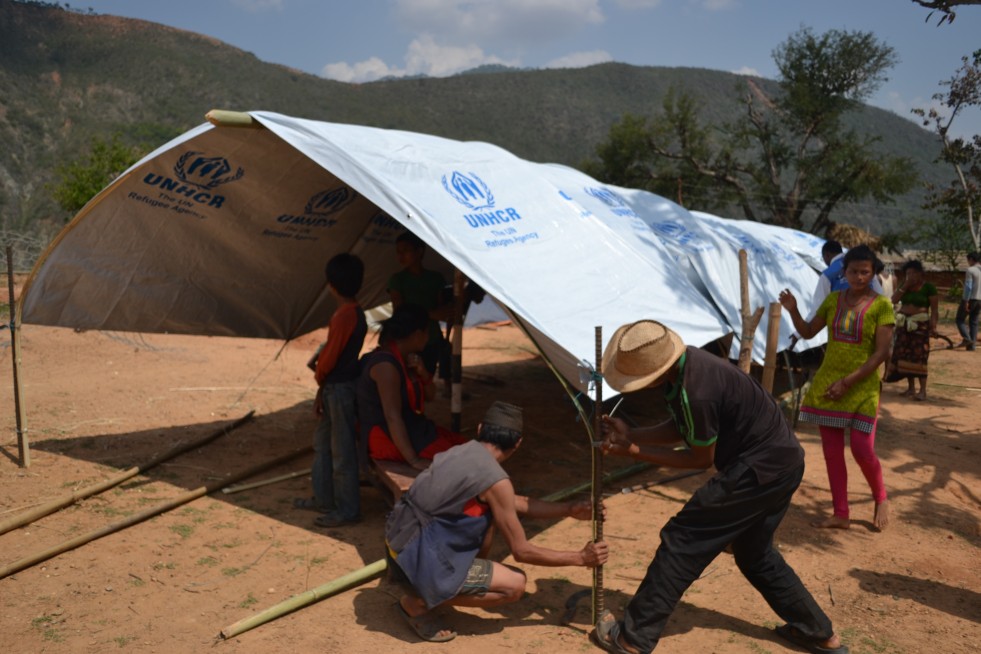
Tarpaulins are used to provide temporary shelter for families. © UNHCR
UNHCR in Action: What do survivors need right now?
Families have been warned not to stay in their houses and buildings fearing further destruction and risk of death from aftershocks, which have continued. Despite the heavy rain, hundreds of thousands have slept outside for several consecutive nights. Adequate shelter is vital for protecting health. Keeping warm and dry can prevent the increased risk of disease and epidemics, particularly for people who are older, already ill, disabled or injured. Private family shelter is important following traumatic events like this. It not only provides a space where families can be together, which can be essential to help them come to terms with all that has happened, but it also provides a safe space for women and girls, to safeguard them against abuse and violence.
Many of the families whose houses were damaged or destroyed are already hard at work repairing their homes or creating their own make-shift temporary accommodation, and we need to provide urgent help in the form of materials to help them mend and waterproof their structures. Tarpaulins are ideal for this purpose, and can also help weather proof and repair community structures. They are often used to create larger spaces where many families can shelter together, protect areas where children can play or provide an environment where medical support can be delivered. UNHCR is often known for providing tents to families who have lost their homes. In this emergency UNHCR is taking a different approach based on the feedback from staff on the ground working with people who have lost everything. Reports indicate that people prefer to receive tarpaulins, which can be combined with wood and bricks to help them build a structure that is more flexible than a simple tent. This is also beneficial for UNHCR, as tents require cleared spaces, which is not a quick solution following devastating events. The compact and lighter tarpaulins allow UNHCR to deliver more supplies despite the limitations of plane weight on the heavily damaged runways at Kathmandu airport.
Natural disasters are terrifying as is, but the repercussions of such catastrophes are much more devastating when so many lives are suddenly plunged into darkness. To offer comfort, UNHCR has provided solar lanterns to those in need. Solar lanterns can also offer protection after night fall, and some can also be used to re-charge mobile telephones, helping people connect with loved ones even in the worst of times.
UNHCR Urgently Needs Your Help:
UNHCR’s 107 staff on the ground and our partners are working tirelessly to provide assistance for those affected, helping keep people alive. We are calling on donors to support our initial appeal for US$3.1 million. The following table shows activities planned in the immediate future.
- Delivery of emergency supplies
Deliver 43,500 tarpaulins/plastic sheets—enough for supporting at least 110,000 survivors
Cost: $2,234,092 - Protection for families
Transportation and delivery of 8,000 solar lanterns to offer light and protection to approximately 40,000 people and 20 solar generators to help provide electricity for communications and other uses
Cost: $580,333 - Community protection monitoring
UNHCR staff are on the ground monitoring and recording where aid is reaching and ensuring that every member of the community regardless of their gender, position in society, age or state of health is able to access help. We are providing this accurate data to highlight the gaps in the aid operation so all agencies can work together to reach survivors
Cost: $295,575



